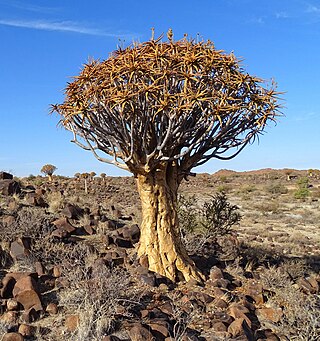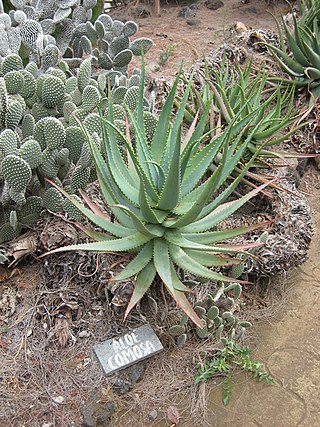
Aloe is a genus containing over 650 species of flowering succulent plants. The most widely known species is Aloe vera, or "true aloe". It is called this because it is cultivated as the standard source for assorted pharmaceutical purposes. Other species, such as Aloe ferox, are also cultivated or harvested from the wild for similar applications.

Aloidendron dichotomum, formerly Aloe dichotoma, the quiver tree or kokerboom, is a tall, branching species of succulent plant, indigenous to Southern Africa, specifically in the Northern Cape province of South Africa, and parts of Southern Namibia.

Aloe arborescens, the krantz aloe or candelabra aloe, is a species of flowering succulent perennial plant that belongs to the genus Aloe, which it shares with the well known and studied Aloe vera. The specific epithet arborescens means "tree-like". Aloe arborescens is valued by gardeners for its succulent green leaves, large vibrantly-colored flowers, winter blooming, and attraction for birds, bees, and butterflies.

Aloe peglerae is a small, stemless South African aloe. This unique succulent plant is classed as an endangered species. The species was listed by CITES as an Appendix II species, requiring special trade protections to prevent the further endangerment of the current wild population due to the plant trade.

Aloe marlothii is a large, single-stemmed Southern African aloe of rocky places and open flat country, occasionally growing up to 6 m tall.

Aloe ballyi is a species of flowering plant in the family Asphodelaceae, native to Kenya and Tanzania.

Aloe comosa is a species of flowering plant in the Asphodelaceae family. It is commonly called Clanwilliam aloe) and is endemic to South Africa.

Gonialoe dinteri, the Namibian partridge aloe, is a species of flowering plant in the Asphodelaceae family. It is native to arid areas of Angola and Namibia.

Aloidendron eminens, formerly Aloe eminens, is a species of succulent plant in the genus Aloidendron, endemic to Somalia.

Aloidendron pillansii, formerly Aloe pillansii, the giant quiver tree or bastard quiver tree, is a large, branching species of succulent plant indigenous to southern Africa. It is regarded as critically endangered.

Aloidendron ramosissimum, formerly Aloe ramosissima, is a species of flowering plant in the family Asphodelaceae. It is endemic to the Richtersveld at the border between South Africa and Namibia, where it grows on desert slopes and in ravines. Its common name is maiden's quiver tree.

Gonialoe sladeniana is a species of plant in the genus Gonialoe. It is endemic to arid areas of central Namibia.
Aloe viridiflora is a species of plant in the genus Aloe. The species is endemic to Namibia with a wide range and is known from at least six different populations. Current trends are not known and the species is listed as LC on the IUCN Red List. However, it is scarce and Namibian authorities consider it threatened; the plant must not be removed or disturbed. It is the only known green-flowering aloe. Its natural habitats are dry savanna, subtropical or tropical dry shrubland, and rocky areas. It can produce hallucinations when ingested, leading to its occasional use in shamanic rituals.
Aloe kilifiensis is a species of plant found on the shores around the Kenya–Tanzania border. It is threatened by the destruction of its habitat for agricultural purposes, and collected because of its flower's distinct coloring.

Aloiampelos gracilis, formerly Aloe gracilis, the rocket aloe, is a succulent plant, endemic to dry thicket vegetation around the city of Port Elizabeth, South Africa. Its natural range lies just to the west of the related Aloiampelos ciliaris, and it occurs in bushy fynbos and dry thickets, and clustered on rocky outcrops at all altitudes. Its range extends westwards into the Baviaanskloof mountains.

Aloe pearsonii is a very distinctive and unusual species of aloe, that is naturally endemic to the arid Richtersveld area on the border between South Africa and Namibia.

Aloe rupestris is an arborescent aloe indigenous to summer-rainfall areas of southern Africa.

Senegalia hereroensis is a species of trees in the genus Senegalia. It is indigenous to Southern Africa.

Aloe volkensii is a species of plant widely distributed in East Africa.

Aloe somaliensis, the Somalian aloe, is a species of flowering plant in the family Asphodelaceae. It is an evergreen succulent perennial native to Somaliland and Djibouti in East Africa, where it grows at altitudes of 700–1,700 metres (2,300–5,600 ft) in bushland on limestone and sandstone rocks.



















